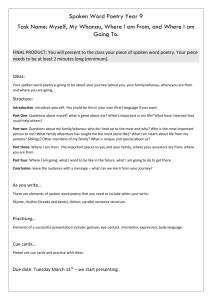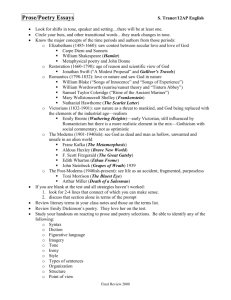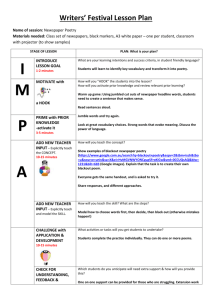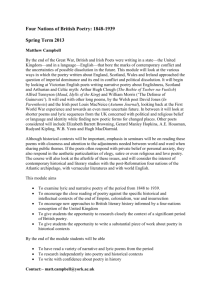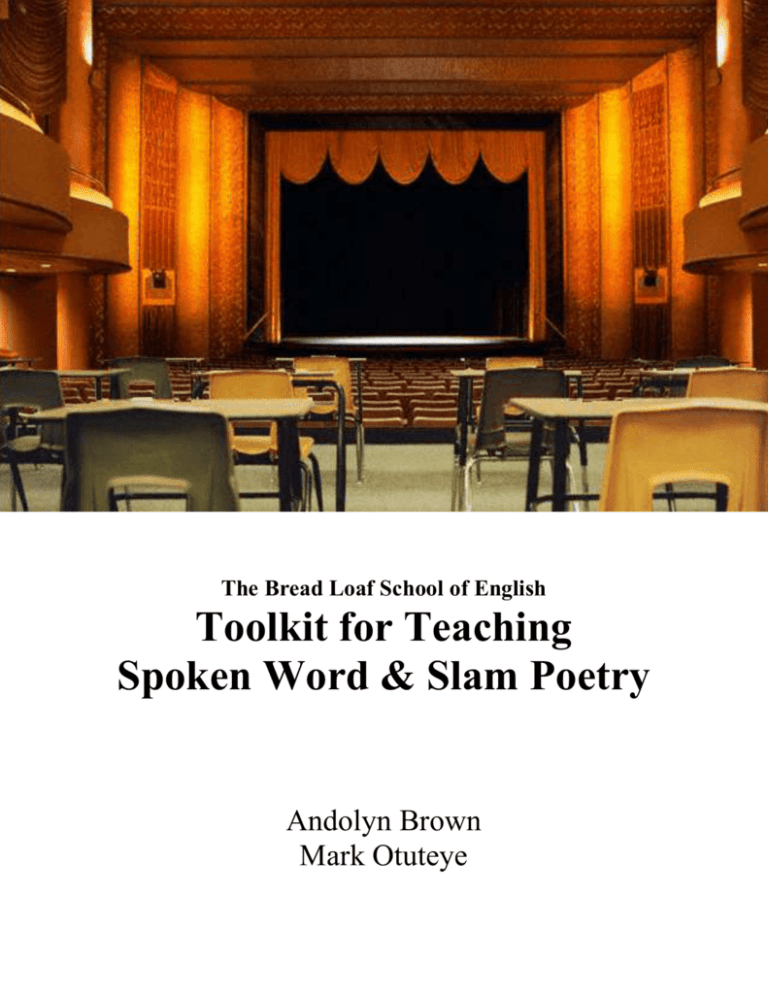
The Bread Loaf School of English
Toolkit for Teaching
Spoken Word & Slam Poetry
Andolyn Brown
Mark Otuteye
Contents
.
Spoken Word Jargon in Plain English
History of Spoken Word & Slam Poetry
Resources for Your Classroom
Lesson Plans
Make-It-Your-Own
Bibliography
2
Spoken Word Jargon in Plain English
.
Spoken Word (n.): A form of performance poetry that emerged in the last 1960’s
from the Black Arts movement. It owes its heritage most directly to the Beat Poetry of
the 1950’s and 1960’s and the Jazz Poetry of the Harlem Renaissance (1920-1940). It
calls directly upon the African American Oral Tradition for much of its aesthetic and
spiritual power (Lorenzo 308).
Slam Poetry (n.): Spoken word poetry that fits into the aesthetic requirement of poetry
slams, most notably, the three-minute time limit (Glazner 13). In this paper, the term
“slam poetry” is used interchangeably with the word “slam.”
Poetry Slam (n.): A competition of spoken word artists in which poets are judged by laypeople in the audience. Audience judges hold up cards scoring the poets from 0.0 to 10.0.
Poets must perform their own work and must finish under a three minute time limit. Slam
poets compete for cash (Glazner 13-14).
Slam (n.): A shorthand way of saying “slam poetry” or of referring to the structure, rules,
and culture of poetry slams.
Slammaster (n.): The Master of Ceremonies at a poetry slam (Glazner 20).
On deck (adj.): A term from slam poetry that describes the poet who will perform after
the next poet due on stage. For example, after each slam poet performs, the slammaster
announces two names, the poet who is immediately next on stage, and the poet who will
follow that poet in performance order. This allows the “on deck” poet time to compose
him or herself and prepare for their turn on stage. The phrase is appropriated from
Karaoke.
To Kick (v.): Appropriated from the rap music phrase “to kick a rhyme,” meaning to rap.
When used in this paper, “to kick” means to perform a spoken word poem.
Slam Poet (n.): Someone who writes and performs slam poetry. Like so many of the
artists in the spoken word scene, slam poets often consider themselves to be both spoken
word artists and social activists.
Collective (n.): A group of spoken word artists.
Piece (n.): A term borrowed from graffiti art and originally short for “masterpiece,” a
piece is a written or performed poem. The terms “piece” and “poem” are used
interchangeably in this paper (“Words”).
Group Piece (n.): The collaborative performance of a spoken word poem (Glazner 214).
The term “group piece” is used interchangeably the term “collaborative piece.”
3
The Audience (n.): Those who come to see spoken word performances. Because spoken
word poets perform their poetry in their own local communities, this term is sometimes
used interchangeably with “community” in this paper.
Spoken Word (n.) vs. Freestyle Rap (n.): Rap is one of the four elements of hip hop
culture (the others are DJ’ing, breakdancing, and graffiti art) in which a person performs
poetry to music in such a way that the beat of the music forms the rhythmic pattern that
his or her words fit into or onto (Rose 22)). In freestyle rap, these words are created
extemporaneously and fit into the rhythm of the music. In spoken word performance,
even if music is involved, the words themselves constitute the rhythmic pattern.
Consequently, spoken word artists are less concerned with fitting their words into or onto
the rhythmic pattern of the music1.
Spoken Word Artist (n.): A term which encompasses various types of oral performers:
rappers, slammers, spoken word poets, and even some performance artists claim this title.
Stanford Spoken Word Collective poets often use this term interchangeably with “spoken
word poet,” “spoken word performer,” and “poet.”
To Stage (v.): As in drama, this term refers to the transitioning of a text into performance
through the addition of movement, timing, and positioning of the performers.
To Cut (v.): To divide a single text into multiple voices. This is often done on computer
word processors by bolding or color-coding poets’ lines.
For a good discussion of the different aesthetics of spoken word poetry and rap music, see Saul Williams’
discussion in the VHS Slamnation (Paul Devlin, 1999)
1
4
A Brief History of Spoken Word and Slam Poetry
.
What do New York’s Nuyorican Poetry Café, South Africa’s Feelah Sistah
Collective, and the Annual International Poetry Olympics in Stockholm, Sweden have in
common with your classroom? Each are literacy communities dedicated to the craft of
writing, speaking, and presentation. Spoken word poetry encourages students to write
about their own lives in their own voices and to perform these stories before and audience
of their peers. One third literacy, one third rhetoric, and one third theater, spoken word
can open up new possibilities in your classroom.
Spoken word poetry is a form of radical performance poetry emerging out of the
political urgency of the Black Arts Movement (1965-1975) (Salaam 1). In the wake of
the killings of John F. Kennedy, Malcolm X, and Dr. Martin Luther King, Jr., many civil
rights activists lost faith that non-violence alone would influence the United States to
reform its policy of racism at home and war abroad. To the “left” of the civil rights
movement, organizations like Students for a Democratic Society (SDS) began to organize
sit-ins at colleges in New York and San Francisco demanding the creation of black
studies departments (Sundiata 03/03/05). Black artists joined the call to arms by declaring
war on racism through their art. As part of their fighting oppression, black artists also
engaged in raising the “consciousness” of black people by spreading messages of black
unity, power, and nationalism. Mobile units of performance poets and drummers, spoken
word collectives responded to the call by spreading the real news about black revolution
and social empowerment on street corners, in community parks, and Black Arts
“revolutionary theaters” (Sundiata 03/03/05). The New York-based Last Poets (1968) and
LA-based Watts Prophets (1965) are the two Black Arts poetry collectives widely
credited with the popularization of the spoken word style (Redmond 320).
Slam poetry is a business structure that puts spoken word poets in mock
competition for cash prizes (Glazner 11). Invented in 1989 by white Chicago construction
worker and bar owner Marc Smith, poetry slams mock the competition in which “real”
poets compete for arts grants, MFA’s, and literary prizes (Glazner 35). City-based slam
venues are connected to one another through Poetry Slam, Inc., a company that manages
5
a national bracket system through its internet website. On the collegiate level, the
national slam is organized through the website of the American College Union. At poetry
slams, five audience members are chosen at random by the slammaster, the master of
ceremonies for the poetry slam. The audience members are given a set of numbered
scorecards and asked to judge individual or group performances of poetry on a scale of
0.0 to 10.0. The scores are recorded by the slam’s scorekeeper, an audience member or
volunteer. Poets must perform their own solo or collaboratively written poetry, without
props, and in a maximum time of three minutes and ten seconds. If the poet goes over the
time limit, points are deducted from the poets overall score. Time penalties are severe and
so serious slam poets are careful to rehearse their poems to make sure they finish without
penalty. The poet or team of poets with the highest score after a round or two of poems
emerges the victor.
Although some spoken word artists bemoan slam poetry as a commercialization
of a politically revolutionary art form2, slam poetry is responsible for securing a national
and international audience for spoken word poetry. For example, the American Academy
of Poets, which has seen its membership burgeon from 2,000 in 1994 to over 10,000 in
1999, openly credits the increased interest in poetry to the rise of spoken word and poetry
slams3. In addition, a great deal of slam poetry is political engaged. For example, when
over one hundred and twenty student poets (including six poets from Stanford’s
Collective) convened at the 2005 Collegiate National Poetry Slam held at West Chester
University, Pennsylvania, the overwhelming majority of their competitive slam poetry
was unabashedly politically progressive, feminist, culturally engaged, and queer friendly.
Every poem performed at a poetry slam is technically a spoken word piece.
Spoken word is the name of an art form while poetry slams are a competitive structure in
which spoken word artists perform. The term “slam poetry” is the name given to spoken
word poetry that conforms to the rules of slam poetry, must notably, the three-minute
time limit. Slam poems are in-your-face and fast-paced because poets have only three
2
In their edited anthology, Bum Rush the Page, Tony Medina & Louis Reye Rivera, poets who were active
in student protests during the Black Arts movement, are explicit about their dislike of “commercialized”
slam. Acclaimed spoken word poet Sekou Sundiata, also an activist in New York during the 60’s, echoed
the same sentiment when I interviewed him on March 3 rd 2005.
3
Weber, Bruce. “Part Art, Part Hip-Hop, And Part Circus: Slammers Shake Up an Interest in Poetry.” New
York Times 04 Apr.1999, natl. ed.
6
minutes to make their case (De Leon 05/22/02). When not performed at slams, spoken
word poems can be any length and are performed at rallies, cultural centers, and street
gatherings. The following chart, figure 1.1, details some of the differences in the origins
of spoken word and the structure of poetry slams.
figure 1.14
Spoken Word Poetry
Origins
Slam Poetry
African American and Native American Oral Traditions
Harlem Renaissance, Beat Poetry Movement, Improv Theater
Important Theorists
Amiri Baraka, Harlem 1965
Marc Smith, Chicago 1989
Art inspired by
Malcolm X assassination
Boring poetry readings
Nostalgia for Beat Poets
Baraka’s Politics vs.
Black Consciousness
Democratize Art
Smith’s Politics
Cultural Nationalism
Save poetry from academics
Early Performers
Last Poets, New York 1968
Patricia Smith, Boston 1990
Watts Prophets, LA 1965
Gary Mex Glazner, SF 1990
Rapping
A sporting event,
Storytelling
Poetic boxing match
Metaphor
Historic Meeting
1994 - Last Poets meet national slam champion Patricia Smith at
Lollapalloza’s Poetry Tent. Poetry Stage organized by slam poet
Juliette Torrez. Spoken word exposed to new audiences in the
Southwest and West Coast. (Glazner 236)
Information the “Spoken Word Poetry” column of this chart was gleaned mostly from Amiri Baraka’s
introduction to Bryant’s On a Mission: The History of the Last Poets (1997). Information for “Slam Poetry”
column of this chart was gleaned mostly from Glazner’s Poetry Slam: The Competitive Art of Performance
Poetry (2000) and selected essays in Eleveld’s The Spoken Word Revolution (2003).
4
7
Resources
.
Video
Furious Flower
I & II by California
News Reel.
(1998, 2005)
<www.newsreel.org>
Furious Flower is collection of black poets from the
Black Arts movement to 1998 (vol. I, 4 VHS, 32
poets, 6 hrs) and from the 1970’s to 2005 (vol. II,
VHS or DVD, 19 poets, 3 hours total). Each volume
contains numerous interviews and performances by
black poets: Amiri Baraka, Sonia Sanchez, Nikki
Giovanni, Eugene Redmond, Rita Dove,
Komunyakaa. These poets built modern spoken
word poetry by fusing together politics, literature,
and community.
SlamNation directed
by Paul Devlin
(1998)
<www.amazon.com>
Books
Furious Flower by
Joanne V. Gabbin
(1998)
<www.amazon.com>
Furious Flower, the book, comes from the same
conference of black poets as the film. It captures in
text and photography the poetry of the over thirty
black poets who came together to honor the legacy
of Gwendolyn Brooks, who in 1950, became the
first African American to win a Pulitzer prize.
SLAM: The
Competitive Art of
Performance Poetry
by Gary Glazner
(2000)
<www.amazon.com>
Devlin’s film Slamnation chronicles the competitors
from the 1996 National Poetry Slam in Portland,
Oregon. The film follows the four-person slam
poetry teams representing twenty-six cities as they
battle and strategize through preliminary rounds.
The film offers an excellent and entertaining
introduction to competitive spoken word poetry.
Also, it features some well written four-person
collaborative spoken word poems.
Gary Mex Glazner produced the very first National
Poetry Slam in San Francisco in 1990. This book is
an anthology of poems and essays from the first ten
years of the National Poetry Slam. You’ll learn the
history, strategy, and culture of slam while also
reading some fine slam poetry.
Def Poetry Jam
Season 1 produced by
Russell Simmons
(2004)
<www.amazon.com>
Bum Rush the Page:
A Def Poetry Jam by
Tony Medina and
Louis Rivera
(2001)
<www.amazon.com>
Produced by Russell Simmons (producer of Def
Comedy Jam), this popular HBO television show
features spoken word artists young and old. Amiri
Barka, Nikki Giovanni, and the Last Poets perform
side by side with Jessica Care Moore, Beau Sia, and
the younger generation of spoken word poets.
Edited by New York based Black Arts activists
Tony Medina and Louis Rivera, this poetry
anthology features, in text, many of the poets from
the Def Poetry Jam DVD as well as many other
emerging voices on the spoken word scene.
8
Lesson Plans
.
Duets – Students collaboratively perform a poem by an
established author.
Back and Forth – Pairs of students collaboratively write a
themed poem.
Found Poem – Students create poetry from the voices of
their own classmates.
Word Palette – Whole class generates a set of words from
which poetry is then written.
Performance Analysis – A video or live performance of a
spoken word poem is used as a catalyst for students’ own
spoken word performances.
9
Duets
Mini Lesson: How do we do “duets”? Explain activity. Perform
duet with another student. Video or CD can be
substituted for live performance.
Read the following poem with a partner. Break up the
Group
poems so that each member of your group dramatizes
Work:
one part of the poem.
Share Aloud: Each group presents duets to the class
Skills:
Elementary
– participate in group meeting
– prepare and deliver a presentation
– Read aloud fluently
Middle School
– participate in group meeting
– prepare and deliver a presentation
High School
– Literary Elements Addressed: tone,
voice, rhyme, theme
– participate in group meeting
– prepare and deliver a presentation
College
Materials
Needed:
– Relation of collaboration to
meaning
– Encode and decode body, voice
into/from text
Copies of engaging poems. Tape recorder (optional)
– “Common Dust” Georgia Douglas Johnson.
– “We Real Cool” Gwendolyn Brooks.
– “Put Something In” by Shel Silverstein.
10
Found Poem
Mini Lesson: What is a collaborative poem? What a Found Poem?
Whole Class: Pass out copies from various books, magazine, song
lyrics, poems, etc. to five students who will be the
readers (we like to call these students “keepers”).
Create a circle out of your class and have the keepers
take the center in a fishbowl. Assign an order to the
keepers and have them read their texts one at a time.
As each keeper reads, all other students (we like to
call them “finders”) write down as many words as
possible, especially those words that strike them or are
of interest. These words should be assembled into a
collage of words, a found poem.
Share Aloud: Have as many students who wish to share, share.
(Optional) Tape record students and play them back
their performances.
Middle School
Skills:
– Prepare and deliver performance
– Synthesize Texts
– Produce work that follows
convention of genre
High School
– Prepare and deliver performance
– Synthesize Texts
– Produce work that follows
convention of genre
Materials
Needed:
Pieces of texts, poems, song lyrics, newspaper
articles, etc. Tape recorder (optional)
11
Back & Forth
Mini Lesson:
What is a theme-based collaborative poem?
Writing on the black board, model collaborative
poem with students.
Group Work:
Introduce a theme to the class. Pair students.
Each pair needs one sheet of paper and two
pen/cils. The goal of each pair is to create a
theme-based collaborative poem about the
theme. The first student should write one word
and pass the paper to her/his partner. The
second student should add two words to their
partner’s work and pass it back. This should
continue for as many cycles as you want (we
suggest no more than 15 words).
Skills:
Elementary & Middle School:
– Deliver performance
– Participate in groups
– Read aloud fluently
– Produce work in genre that
follows conventions of genre
High School
– Literary Elements: Theme
– Deliver performance
– Participate in groups
– Read aloud fluently
– Produce work in genre that
follows conventions of genre
Each group stands up in front of the class and
presents Back & Forth.
Share Aloud:
Materials Needed: Paper and pen/cils. Model of collaborative
poems.
12
Word Palette
Mini Lesson:
What is a Word Palette?
Whole Class:
Create a table with four columns. The titles of
each column should be: “Things of Value,”
“Places You’ve Never Been,” “Things You Want
to Change in the World,” and “Myths.” Ask class
to brainstorm five words for each column. Every
student should be modeling/copying your chart
on their own paper. Students should update their
paper with each new word volunteered by a
classmate.
Individual Work: Have each student circle three words from each
list that they want to write about. These words
should be used in a free write poem.
Share Aloud:
Each student presents Word Palette to the class.
Skills:
Middle School: prepare and deliver performance
High School: Literary Elements: diction. Prepare
and deliver performance
Materials
Needed:
Students need paper and pen/cils. Black board/
white board/ or chart paper.
13
Performance Analysis
Mini Lesson:
What is Spoken Word? (included in packet).
Group Work:
Watch a spoken word piece from video or
perform a piece (or bring in a performer). Ask the
class what they noticed from the performance.
Add things that you think they should notice.
Individual
Work:
Ask students to prepare spoken word pieces that
include all of the elements noticed based on
theme given by the teacher or themes that
students themselves create.
Share Aloud:
Have each student stand in front of the class and
dramatize her or his spoken word piece and
analyze why it is a spoken word piece.
Skills:
High School
– Prepare and deliver individual
spoken word performance.
– Produce work in genre that
follows conventions of the
genre.
– Literary Elements: genre,
theme, dramatization.
College
– Relationship between
performance and self
– Self-performed vs. Non-self
performed texts.
Materials
Needed:
Video of spoken word poetry. Paper and pen/cils.
14
Poems to Dramatize
.
Put Something In — Shel Silverstein
Common Dust — Georgia Douglas Johnson
We Real Cool — Gwendolyn Brooks
Entropy — Mark Otuteye
Father’s Child — Andolyn Brown & Mark Otuteye
15
Put Something In
by Shel Silverstein
Draw a crazy picture,
Write a nutty poem,
Sing a mumble-gumble song,
Whistle through your comb.
Do a loony-goony dance
‘Cross the kitchen floor,
Put something silly in the world
That ain’t been there before.
Draw a crazy picture,
Write a nutty poem,
Sing a mumble-gumble song,
Whistle through your comb.
Do a loony-goony dance
‘Cross the kitchen floor,
Put something silly in the world
That ain’t been there before.
16
Common Dust
Georgia Douglas Johnson
And who shall separate the dust
What later we shall be:
Whose keen discerning eye will scan
And solve the mystery?
The high, the low, the rich, the poor,
The black, the white, the red,
And all the chromatique between,
Of whom shall it be said:
Here are the sons of Africa;
Here lies the dust of Rome;
Here lies the one unlabeled,
The world at large his home!
Can one then separate the dust?
Will mankind lie apart,
When life has settled back again
The same as from the start?
17
We Real Cool
Gwendolyn Brooks
THE POOL PLAYERS.
SEVEN AT THE GOLDEN SHOVEL.
We real cool. We
Left school. We
Lurk late. We
Strike straight. We
Sing sin. We
Thin gin. We
Jazz June. We
Die soon.
18
Entropy
Mark Otuteye
I didn’t know so I asked my mama.
Mama? How come it’s so much easier
To break something apart than to build?
I see men spend years raising a skyscraper
30 minutes to bring it down
In twin mushroom clouds
Of stinging concrete blast and dust
In God we trust I heard a Christian say
Trying to sell me a sermon of salvation
Said the devil’s the reason things fall apart.
After class I asked my math + physics teacher
Why it seems to me there be a large minus sign
Riding on everything.
Well son, entropy is increasing exponentially
So soon there won’t be anything beautiful
Nothing will hold together
So mama I’m confused
And I wanna hear from you
Why things break down and ain’t beautiful
And why evil seems to have it so easy
She said baby
That’s something you can change
She said, that’s why I had you.
19
Father’s Child
collaboratively written and performed by
Mark Otuteye and Andolyn Brown
[I am my father’s child]
Slim waist, thick hips, dark ink finger tips
I am the product of two parents who once tried to
change the world and ended up instead [with me.]
I am [1203 Hopkins Street]
JJ and Keita ridin’two wheelers
Gus tryin’ not to step on a crack [and break his
mothers back.]
I am 1410 South Pembrooke Lane.
I am [orange sunsets] and [blue sky] thrown
overhead.
Playin’ basketball till we wear out the day and the
stars gotta hold up the night.
I am heated tempers after Friday night rituals.
Screaming voices behind the door. Violent images
of love? [I am my father’s child].
I am the daughter of a garbage collector. [Hard
workin’ protector]. Does he love me? Who cares
he took care of me to make me into who I am.
I am my father’s daughter.
20
I am a poetic [organizer,] apathy [despiser,]
[collective eclectic poetic rhyme synthesizer]
Heating poems in heart or in hand and I work with
16 of the coolest poets [in all the land].
I am Bynum, [bindin’ them together] self and song.
I am Black [Blow.] Me and dad playin’ basketball.
Dad says you gotta have killer instinct. [You gotta
finish.] So I give him a shake and I’m gone in a
dream at the net with the wind. And one, DAD.
Count THAT
SSShhhhh. I am southern towns, freshly mowed
grass, finely manicured hedges, hot sun burnin’ off
the misty haze. I am girl scout trips, god mothers
singin’ hymns [on the back porch]. I am Saturday
mornin’ pancakes, fishin’ trips [and still waters].
[I am my father’s child]
I am the product of two parents who once tried to
change the world and ended up instead [with me.]
NOTE: Plain text is read by Andolyn Brown. Bold
text is read by Mark Otuteye. Bold and bracketed text
is read by both.
21
Make-It-Your-Own
.
Mini Lesson:
Group Work:
Individual
Work:
Share Aloud:
Skills:
Materials
Needed:
22
Bibliography of Spoken Word
Angelsey, Zoë. Listen Up!: Spoken Word Poetry. New York: Ballentine Books, 1999.
Alfano, Christine L. and Alyssa J. O’brien. Envision. New York: Pearson/Longman,
2005.
Algarin, Miguel and Bob Holman. Aloud: Voices from the Nuyorican Poets Café. Henry
Holt and Company: New York, 1994.
Aristotle. Poetics. Trans. Gerald F. Else. Michigan UP, 1970.
Bartholomae, David. “Wanderings: Misreadings, Miswriting, Misunderstandings.” Only
Connect: United Reading and Writing. Ed. Thomas Newkirk. New Jersey:
Boynton/Cook, 1986. 89-118
“Beat movement.” Encyclopedia Britannica. June 12, 2002.
<http://www.britannica.com/eb/article?eu=14132>]
Bonair-Agard, Roger. Burning Down the House: Selected Poems from the Nuyorican
Poets Cafe's National Poetry Slam Champions. New York: Soft Skull Press,
2000.
Bizzel, Patricia and Bruce Herzberg. The Rhetorical Tradition. Boston:
Bedford/St.Martins, 1992. 1182-1205.
Bryant, Nelson. On a Mission: Selected Poems and a History of The Last Poets. New
York: 21st Century, 1997.
Burke, Kenneth. A Grammar of Motives. Berkeley: U of California P, 1969.
———. A Philosophy of Literary Form. 3rd
Cooper, Anna Julia. 1892. “Womanhood a Vital Element in the Regeneration and
Progress of a Race.” The Norton Anthology of African American Literature. Ed.
Gates, Henry Louis Jr. and Nellie Y. McKay. New York: W. W. Norton &
Company, 2004.
Crowley, Sharon and Deborah Hawhee. Ancient Rhetorics for Contemporary Students.
Boston: Allyn and Bacon, 1999.
Damon, Maria. “Was that ‘Different,’ ‘Dissident,’ or Dissonant’? Poetry in the public
Spear: Slams, Open Readings, and Dissident Traditions.” Ed. Charles Bernstein.
Close Listening: Poetry and Performance. New York: Oxford UP, 1998. 324-342.
Devlin, Paul. Slamnation. Saul Williams, Jessica Care Moore. Taylor Mali. SlamNation.
1999. VHS. (production company not given). 1998.
Diamon, Elin. Performance and Cultural Politics. London: Routledge, 1996.
Elbow, Peter. Writing Without Teachers. New York: Oxford UP, 1998.
23
Eleveld, Mark. The Spoken Word Revolution. Illinois: Sourcebooks, 2003
Feinstein, Sascha and Yusef Komunyakaa. The Jazz Poetry Anthology. Indianapolis:
Indiana UP, 1991.
Foucault, Michel. “What Is An Author?.” The Foucault Reader. Ed. Paul Rabinow. New
York: Pantheon Books, 1994.
Gilyard Keith and Vorris Nunley. Rhetoric and Ethnicity. Portsmouth: Boynton/Cook,
2004.
Glazner, Gary Mex. Poetry Slam: The Competitive Art of Performance Poetry. Manic D
Press: San Francisco, 2000.
Harper, Michael S. Every Shut Eye Ain’t Asleep: an anthology of African American
Poetry Since 1945. Back Bay Books: Boston, 1994.
Heidegger, Martin. Poetry, Language, Thought. Trans. by Albert Hofstadter. New York:
Harper & Row, 1997.
Heintz, Kurt. “An Incomplete History of Slam.” 09 June 2002 <http://www.epoets.net/library/slam/index.html>
Hiltz, V. A.. “The Black Arts Repertory Theatre/School.” 12 June 2002.
<http://www.umich.edu/~eng499/orgs/barts.html>
Hodges, John. Furious Flower I: Warriors. 1998. VHS. California Newsreel.
Katz, Shaina and Matt Woloszyn. Personal Interview. 27 February 2005
Lathan, Stan and Danny Hoch. Def Poetry Jam. 2004. DVD. 2002 Warner Home Video.
Levin, Mark.. Saul Williams. Slam. 2003. DVD. Vidmark./Trimark. 1998.
Lewis, Jessica, Takeo Rivera, and Lisa Tittle. Personal Interview. 05 March 2005
Lunsford, Andrea and Lisa Ede. Single Texts/Plural Authors. Illinois: Southern Illinois
University, 1990.
———. Observations from the Stanford Study of Writing. San Francisco Moscone
Center. 19 March 2005
Mahiri, Jabari. What They Don't Learn in School: Literacy in the Lives of Urban Youth.
Peter Lang Publishers, 2003.
Medina, Tony and Louis Reyes Rivera. Bum Rush the Page. New York: Three Rivers
Press, 2001.
Moi, Toril. Sexual/Textual Politics: Feminist Literary Theory. 2nd ed. New York:
Routledge, 2002.
Randall, Dudley. The Black Poets. New York: Bantam Books, 1985.
24
Redmond, Eugene. Drumvoices: The mission of Afro-American poetry : a critical history.
Anchor P, 1976.
Rivera, Takeo. Personal Interview. 22 April 2005
Rose, Tricia. Black Noise: Rap Music and Black Culture in Contemporary America.
Connecticut: Wesleyan UP, 1994.
Salaam, Kalamu ya. “Poetry in the Black Arts Movement.” The Oxford Companion to
African American Literature. New York: Oxford UP, 1997.
Schreiber, Kim. Personal Interview. 14 April 2004
Simmons, Russell. Def Poetry Jam. New York: HBO Video, 2004.
Simmons, Danny. Def Poetry Jam on Broadway… and More. New York: Atrai Books,
2003.
Smitherman, Geneva. Talkin and Testifyin: The Language of Black America. Boston:
Houghton Mifflin, 1977.
Sundiata, Sekou. Personal Interview. 03 Mar 2005
Thiongo, Ngugui Wa. Decolonising the Mind: The Politics of Language in African
Literature. Kenya: East Africa Educational Publishers, 2003.
Thomas, Lorenzo. “Neon Griot: The Functional Role of Poetry Readings in the Black
Arts Movement.” Ed. Charles Bernstein. Close Listening: Poetry and
Performance. New York: Oxford UP, 1998. 324-3
Weber, Bruce. “Part Art, Part Hip-Hop and Part Circus; Slamers Shake Up An Interest in
Poetry.” New York Times 16 Aug. 1999: E1. Online. Lexis-Nexis Database.
Search String: poetry slam.
Weiss, Jen and Scott Herndon. Brave New Voices: the YOUTH SPEAKS Guide to
Teaching Spoken Word Poetry. New Hampshire: Heinemann, 2001.
“Words: A Graffiti Glossary, The.” 5/17/2005.
<http://www.graffiti.org/faq/graffiti.glossary.html>
Williams, Saul. Amethyst Rockstar. CD. American, 2001.
———. Saul Williams. CD. Fader Label, 2004.
Witcher, Theodore. Nia Long and Larenz Tate. Love Jones. DVD. 2004. New Line
Entertainment. 1997.
25



